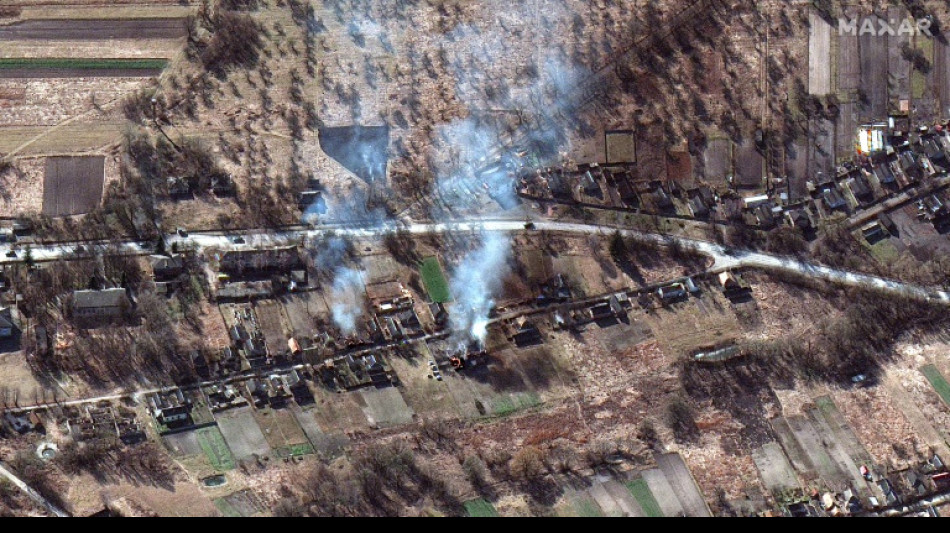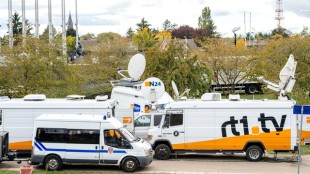
-
 French readers lap up Sarkozy's prison diaries
French readers lap up Sarkozy's prison diaries
-
UK PM warns Abramovich 'clock is ticking' over Chelsea sale fund

-
 Warner Bros. Discovery rejects Paramount bid
Warner Bros. Discovery rejects Paramount bid
-
Winners of 2026 World Cup to pocket $50 million in prize money

-
 World no. 1 Alcaraz ends 'incredible ride' with coach Ferrero
World no. 1 Alcaraz ends 'incredible ride' with coach Ferrero
-
World number one Alcaraz announces 'difficult' split with coach Ferrero

-
 Iran boxer sentenced to death at 'imminent' risk of execution: rights groups
Iran boxer sentenced to death at 'imminent' risk of execution: rights groups
-
Snicko operator admits error that led to Carey's Ashes reprieve

-
 Finland PM apologises to Asian countries over MPs' mocking posts
Finland PM apologises to Asian countries over MPs' mocking posts
-
Doctors in England go on strike for 14th time

-
 Romania journalists back media outlet that sparked graft protests
Romania journalists back media outlet that sparked graft protests
-
Rob Reiner's son awaiting court appearance on murder charges

-
 Ghana's Highlife finds its rhythm on UNESCO world stage
Ghana's Highlife finds its rhythm on UNESCO world stage
-
Stocks gain as traders bet on interest rate moves

-
 France probes 'foreign interference' after malware found on ferry
France probes 'foreign interference' after malware found on ferry
-
Europe's Ariane 6 rocket puts EU navigation satellites in orbit

-
 Bleak end to the year as German business morale drops
Bleak end to the year as German business morale drops
-
Hundreds queue at Louvre museum as strike vote delays opening

-
 Bondi shooting shocks, angers Australia's Jewish community
Bondi shooting shocks, angers Australia's Jewish community
-
Markets rise even as US jobs data fail to boost rate cut bets

-
 Senegal talisman Mane overcame grief to become an African icon
Senegal talisman Mane overcame grief to become an African icon
-
Carey pays tribute to late father after home Ashes century

-
 'Many lessons to be learned' from Winter Games preparations, says ski chief
'Many lessons to be learned' from Winter Games preparations, says ski chief
-
Emotional Carey slams ton to give Australia upper hand in 3rd Ashes Test

-
 Asian markets mixed as US jobs data fails to boost rate cut hopes
Asian markets mixed as US jobs data fails to boost rate cut hopes
-
Carey slams ton as Australia seize upper hand in third Ashes Test

-
 Bondi shooting shocks, angers Australia Jewish community
Bondi shooting shocks, angers Australia Jewish community
-
Myanmar junta seeks to prosecute hundreds for election 'disruption'

-
 West Indies hope Christmas comes early in must-win New Zealand Test
West Indies hope Christmas comes early in must-win New Zealand Test
-
Knicks beat Spurs in NBA Cup final to end 52-year trophy drought

-
 Khawaja revels in late lifeline as Australia 194-5 in 3rd Ashes Test
Khawaja revels in late lifeline as Australia 194-5 in 3rd Ashes Test
-
Grief and fear as Sydney's Jewish community mourns 'Bondi rabbi'

-
 Trump orders blockade of 'sanctioned' Venezuela oil tankers
Trump orders blockade of 'sanctioned' Venezuela oil tankers
-
Brazil Senate to debate bill to slash Bolsonaro jail term

-
 New Zealand ex-top cop avoids jail time for child abuse, bestiality offences
New Zealand ex-top cop avoids jail time for child abuse, bestiality offences
-
Eurovision facing fractious 2026 as unity unravels

-
 'Extremely exciting': the ice cores that could help save glaciers
'Extremely exciting': the ice cores that could help save glaciers
-
Asian markets drift as US jobs data fails to boost rate cut hopes

-
 What we know about Trump's $10 billion BBC lawsuit
What we know about Trump's $10 billion BBC lawsuit
-
Ukraine's lost generation caught in 'eternal lockdown'

-
 'Catastrophic mismatch': Safety fears as Jake Paul faces Anthony Joshua
'Catastrophic mismatch': Safety fears as Jake Paul faces Anthony Joshua
-
Australia's Steve Smith ruled out of third Ashes Test

-
 Khawaja grabs lifeline as Australia reach 94-2 in 3rd Ashes Test
Khawaja grabs lifeline as Australia reach 94-2 in 3rd Ashes Test
-
Undefeated boxing great Crawford announces retirement

-
 Trump says orders blockade of 'sanctioned' Venezuela oil tankers
Trump says orders blockade of 'sanctioned' Venezuela oil tankers
-
UK experiences sunniest year on record

-
 Australia holds first funeral for Bondi Beach attack victims
Australia holds first funeral for Bondi Beach attack victims
-
FIFA announces $60 World Cup tickets after pricing backlash

-
 Maresca relishes support of Chelsea fans after difficult week
Maresca relishes support of Chelsea fans after difficult week
-
Medical Care Technologies, Inc. (OTC Pink:MDCE) Announces Completion of AI-Based Consumer App, Now in iOS App Store Review


How commercial satellites are shaping the Ukraine conflict
From a huge Russian military convoy snaking its way to Kyiv to missile strikes and refugee crossings, commercial satellite imagery of the Ukraine conflict is helping lift the fog of war, illuminating for the public what was previously the domain of spy agencies.
Technologies that can pierce cloud cover and work at night are also coming to the fore, as a growing army of open-source intelligence analysts offer near real time assessments of battleground developments.
"Governments are no longer the only place to go for high precision satellite data," Craig Nazareth, a former US intelligence officer turned scholar at the University of Arizona, told AFP.
Thanks to the explosive growth of the private satellite industry, the volume of imagery is greater and turnaround time faster compared to prior conflicts, such as Russia's 2014 annexation of Crimea.
While most Western governments have their own sophisticated satellite assets, their classified nature means the images can't be shared.
And with public trust in the US and British governments shaken after the 2003 Iraq war, third-party imagery has helped plug credibility gaps.
"They're saying 'Look, it's not us, this is actually happening, we're not making this up," Nazareth said.
Beyond helping shape narratives, the images are directly aiding Ukrainian forces in their war efforts.
"Capella Space is working directly with the US and Ukrainian governments as well as other commercial entities to provide timely data and assistance around the ongoing conflict," Payam Banazadeh, the company's CEO confirmed in a statement to AFP.
- Radar imagery -
It was images taken by the San Francisco startup that led a group of independent researchers to realize the invasion was underway, before Vladimir Putin announced his "special military operations" in the early morning of February 24.
Hours before that speech, Jeffrey Lewis of the Middlebury Institute in California tweeted that Google Maps showed a "traffic jam" on the road from Belgorod, Russia to the Ukrainian border.
It was the precise spot Capella Space previously saw a convoy of military vehicles, and the congestion likely reflected Russian civilians getting stuck at roadblocks while military vehicles passed.
"Someone's on the move," he correctly hypothesized.
While most satellite imaging requires daylight and clear skies to capture images, Capella Space works with synthetic aperture radar (SAR) -- in which sensors shoot down energy, then record the amount that reflects back to them.
SAR "penetrates clouds and smoke, even in very large storm events or fires, so we can reliably capture clear and precise images of the Earth under almost any conditions," said Dan Getman, the company's vice president of product.
Another company whose pictures have been used heavily by news media is BlackSky, which released what it believes was among the first engagements of the war -- an attack on the Luhansk Thermal Power Station a little after 4:00 pm local time on February 23.
"We have a constellation of small satellites that can see dawn to dusk, not just at certain times of the day" the company's CEO Brian O'Toole told AFP.
In traditional polar orbits, which fly north-south, a satellite could take only two snaps of a particular spot per day -- but BlackSky flies its hardware counter-clockwise to the planet's rotation, allowing them to revisit areas more often.
Clients receive the images within 90 minutes, and are helped in interpreting them by AI-enabled software.
- Future ethical concerns? -
Perhaps the most grabbing image of the conflict so far has been a picture of the 40 mile (64 km) long Russian convoy, captured by Maxar, "the granddaddy of the industry," according to Chris Quilty, of Quilty Analytics.
He explained that unlike traditional satellites that only point downwards, Maxar's satellites have gyroscopes that allow them to swivel and target with more precision.
The US government, through the National Reconnaissance Office, is one of Maxar's main clients, dictating "shutter time," which helps explain why the company and others are spending so much time over Ukraine right now.
But the selective release of what the satellites are seeing could eventually lead to ethical concerns.
Maxar and others "are inevitably capturing imagery of Ukrainian troop movements and defensive positions and that information is not being released to the public," said Quilty.
Looking ahead to future conflicts, "There is absolutely an ability to color the narrative depending upon what imagery is made available," he said.
A.O.Scott--AT



